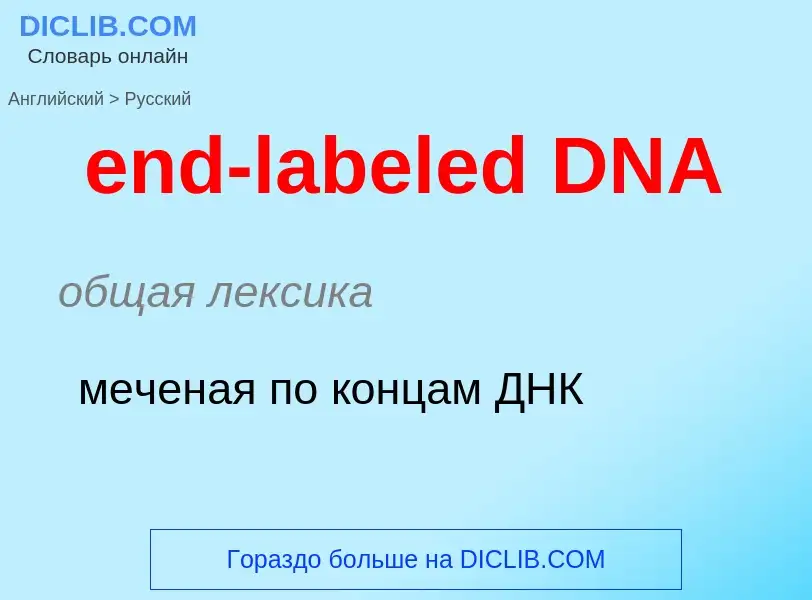Перевод и анализ слов искусственным интеллектом ChatGPT
На этой странице Вы можете получить подробный анализ слова или словосочетания, произведенный с помощью лучшей на сегодняшний день технологии искусственного интеллекта:
- как употребляется слово
- частота употребления
- используется оно чаще в устной или письменной речи
- варианты перевода слова
- примеры употребления (несколько фраз с переводом)
- этимология
end-labeled DNA - перевод на русский
общая лексика
меченая по концам ДНК
общая лексика
ДНК
дезоксирибонуклеиновая кислота
(Distributed Internet Application) распределённые приложения Интернет, архитектура DNA
(Digital Network Architecture) архитектура цифровой сети
сетевая архитектура, разработанная корпорацией Digital Equipment. Реализована в сети DECnet
синоним
Смотрите также
существительное
общая лексика
архитектура цифровых сетей
синоним
['s(j)u:pəkɔil]
общая лексика
суперспираль
спираль второго порядка
синоним
['s(j)u:pəkɔild]
биохимия
сверхспиральный (об укладке молекулы ДНК)
прилагательное
биохимия
сверхспиральный (об укладке молекулы ДНК)
общая лексика
рекомбинантная ДНК
общая лексика
химерный [рекомбинантный] белок
медицина
рекомбинационный белок
общая лексика
сверхспиральная ДНК
синоним
общая лексика
дезоксирибонуклеиновая кислота
ДНК
химия
кислота дезоксирибонуклеиновая
медицина
ДНК (дезоксирибонуклеиновая кислота)
общая лексика
двунитевая [двухцепочечная] ДНК
Определение
Википедия
Doubly labeled water is water in which both the hydrogen and the oxygen have been partly or completely replaced (i.e. labeled) with an uncommon isotope of these elements for tracing purposes.
In practice, for both practical and safety reasons, almost all recent applications of the "doubly labeled water" method use water labeled with heavy but non-radioactive forms of each element (deuterium and oxygen-18). In theory, radioactive heavy isotopes of the elements could be used for such labeling; this was the case in many early applications of the method.
In particular, doubly labeled water (DLW) can be used for a method to measure the average daily metabolic rate of an organism over a period of time (often also called the Field metabolic rate, or FMR, in non-human animals). This is done by administering a dose of DLW, then measuring the elimination rates of deuterium and oxygen-18 in the subject over time (through regular sampling of heavy isotope concentrations in body water, by sampling saliva, urine, or blood). At least two samples are required: an initial sample (after the isotopes have reached equilibrium in the body), and a second sample some time later. The time between these samples depends on the size of the animal. In small animals, the period may be as short as 24 hours; in larger animals (such as adult humans), the period may be as long as 14 days.
The method was invented in the 1950s by Nathan Lifson and colleagues at the University of Minnesota. However, its use was restricted to small animals until the 1980s because of the high cost of the oxygen-18 isotope. Advances in mass spectrometry during the 1970s and early 1980s reduced the amount of isotope required, which made it feasible to apply the method to larger animals, including humans. The first application to humans was in 1982, by Dale Schoeller, over 25 years after the method was initially discovered. A complete summary of the technique is provided in a book by British biologist John Speakman.



![DNA major and minor grooves. The latter is a binding site for the [[Hoechst stain]] dye 33258. DNA major and minor grooves. The latter is a binding site for the [[Hoechst stain]] dye 33258.](https://commons.wikimedia.org/wiki/Special:FilePath/DNA-ligand-by-Abalone.png?width=200)
![animated version]]). animated version]]).](https://commons.wikimedia.org/wiki/Special:FilePath/DNA animation.gif?width=200)

![B]] and [[Z-DNA]] B]] and [[Z-DNA]]](https://commons.wikimedia.org/wiki/Special:FilePath/Dnaconformations.png?width=200)

.jpg?width=200)




![[[Maclyn McCarty]] (left) shakes hands with [[Francis Crick]] and [[James Watson]], co-originators of the double-helix model based on the X-ray diffraction data and insights of Rosalind Franklin and Raymond Gosling. [[Maclyn McCarty]] (left) shakes hands with [[Francis Crick]] and [[James Watson]], co-originators of the double-helix model based on the X-ray diffraction data and insights of Rosalind Franklin and Raymond Gosling.](https://commons.wikimedia.org/wiki/Special:FilePath/Maclyn McCarty with Francis Crick and James D Watson - 10.1371 journal.pbio.0030341.g001-O.jpg?width=200)
![Interaction of DNA (in orange) with [[histone]]s (in blue). These proteins' basic amino acids bind to the acidic phosphate groups on DNA. Interaction of DNA (in orange) with [[histone]]s (in blue). These proteins' basic amino acids bind to the acidic phosphate groups on DNA.](https://commons.wikimedia.org/wiki/Special:FilePath/Nucleosome1.png?width=200)




![The Eagle]] [[pub]] commemorating Crick and Watson The Eagle]] [[pub]] commemorating Crick and Watson](https://commons.wikimedia.org/wiki/Special:FilePath/TheEaglePub-Cambridge-BluePlaque.jpg?width=200)





